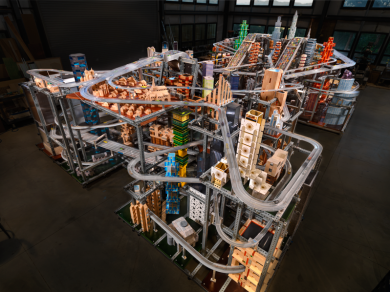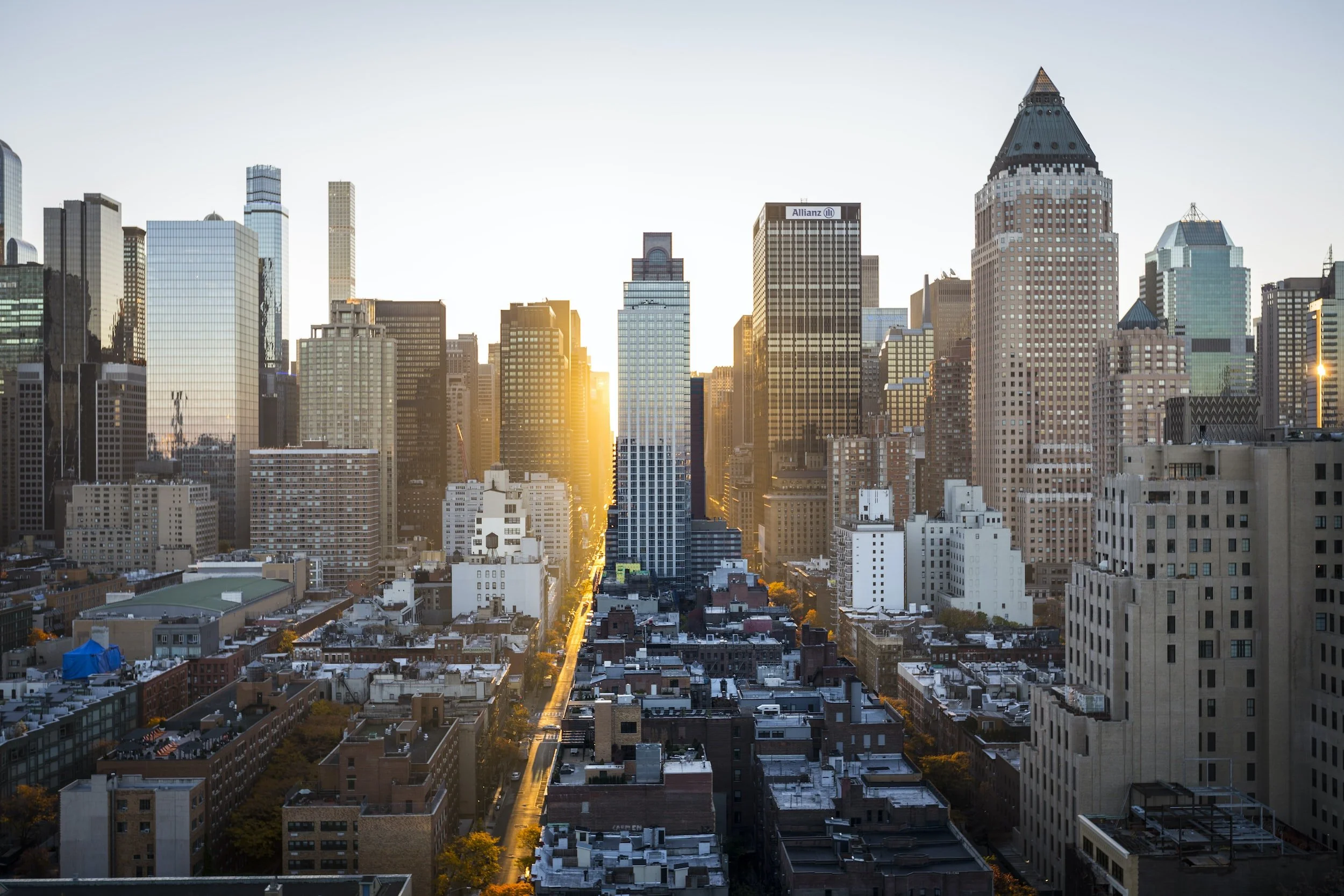How and within which frameworks are artists part of the future city? Is art a critical element in the relationship between future cities and future citizens? Municipal leaders are realizing that smart city strategies start with people, not technology.
#TBT: WOYP & Top Tech Article
The Future of Cities, in Sculpture Form
As the resident policy nerd here at Tech in the Arts, few things excite me as much as infrastructure policy, especially as it relates to cities and how they will evolve and change in the years and decades to come. The “city of the future” concept has been around for as long as the republic itself, with the same questions often being asked: how will people live? What will our houses look like? And, perhaps most importantly, when will we get the flying car?
Instead of futuristic fantasies that have little hope of implementation, I often favor the realistic side of things, and am drawn to concepts of future cities that incorporate existing technologies and the gradual improvements that we will no doubt see in our future metropolises. With mega cities becoming a larger part of the American psyche and gradually accounting for a higher and higher percentage of our nation’s population, the incentive to promote and showcase cities of the future has never been higher.
relates to cities and how they will evolve and change in the years and decades to come. The “city of the future” concept has been around for as long as the republic itself, with the same questions often being asked: how will people live? What will our houses look like? And, perhaps most importantly, when will we get the flying car?
Instead of futuristic fantasies that have little hope of implementation, I often favor the realistic side of things, and am drawn to concepts of future cities that incorporate existing technologies and the gradual improvements that we will no doubt see in our future metropolises. With mega cities becoming a larger part of the American psyche and gradually accounting for a higher and higher percentage of our nation’s population, the incentive to promote and showcase cities of the future has never been higher.
A new exhibit opened this past weekend in Los Angeles seeks to show what kind of city we may gradually evolve into. Metropolis II, by artist Chris Burden, currently on display Fridays and weekends at the Los Angeles County Museum of Art, is a living, breathing, working model of a futuristic city designed around transportation and infrastructure. Instead of a computer model or video game, this exhibit is a handmade, painstakingly detailed work of art that shows a city in action.
The scale of the exhibit is quite impressive. In total it is about 500 square feet and is about ten feet tall at its highest point. While there are no flying cars, there are actual miniature cars included in the exhibit, and lots of them: over the span of an hour, over 100,000 tiny cars whiz through the exhibit, speeding between buildings and skyscrapers. There are eighteen roadways handling all of these cars, including a 6-lane freeway. Trains are included as well, with tracks that loop through the exhibit; taken together; all of these cars and trains speeding through the exhibit at such breakneck speed produce a visual and audio experience unlike any other, as the viewer is able to experience the sights and sounds of a futuristic and thriving metropolis.
Designed and built over a span of five years, the exhibit is absolutely worth a look. Here’s a short film looking at the design and production of the sculpture:
http://youtu.be/YqSkRgySAEg
While some may prefer the futuristic futures of films like ‘Blade Runner,’ I enjoy the works of art that look at how cities will evolve and change in the short term. Faster cars, more drivers, taller buildings, denser neighborhoods; these are all characteristics of future cities that seem to be realistic in the short term. The great thing about Burden’s exhibit is how he takes modest changes to our current city structures, like more cars and expanded expressways, and is able to depict the frenzied and bustling future of our cities in a simple and straightforward way.
The exhibit is currently on display in Los Angeles, and if you are in the area, it is definitely worth a look. It may not appeal to futuristic film lovers, but for transportation and infrastructure policy nerds like myself, it is a reminder of why we are so interested in the futures of our wonderful and dynamic major cities.
(Photo credit: Los Angeles County Museum of Art)
In An Era of Budget Austerity, Public Art Projects Take on Increased Impact
 One of the unfortunate realities of the current economic climate is that with so many Americans unemployed, and others saving money instead of using it to purchase goods and services, the states, counties and municipalities that rely so heavily on sales tax collections are faced with fewer tax collections and larger annual budget deficits. With most local governments required to balance their budgets every fiscal year, they are forced to cut spending, lay off workers and delay investment on previously planned projects.
Since the 2007 recession, this trend has spread towards nearly every corner of America. As it relates to the arts community, investments in public works of art, like sculptures, statues and murals, have been shelved due to budget cuts. However, at the same time, a rise in grassroots public art projects, funded using online crowdfunding programs, have helped deliver quirky and imaginative works of art to cities nationwide, bringing a small sense of civic pride back to areas devastated by the economic downturn.
One of the unfortunate realities of the current economic climate is that with so many Americans unemployed, and others saving money instead of using it to purchase goods and services, the states, counties and municipalities that rely so heavily on sales tax collections are faced with fewer tax collections and larger annual budget deficits. With most local governments required to balance their budgets every fiscal year, they are forced to cut spending, lay off workers and delay investment on previously planned projects.
Since the 2007 recession, this trend has spread towards nearly every corner of America. As it relates to the arts community, investments in public works of art, like sculptures, statues and murals, have been shelved due to budget cuts. However, at the same time, a rise in grassroots public art projects, funded using online crowdfunding programs, have helped deliver quirky and imaginative works of art to cities nationwide, bringing a small sense of civic pride back to areas devastated by the economic downturn.
We here at Technology in the Arts have previously looked at the crowdfunding website Kickstarter, which serves as a simple way for artists to solicit and accept donations for arts projects from people online. The way the site works is simple: an artist has an idea, he/she sets a fundraising goal that they wish to achieve, and they have three months to reach that dollar amount. The artist will often design a list of rewards for donors to motivate them to donate, and if the project does not reach its fundraising goal by the end of the three month time period, no money is spent and all money is returned.
Kickstarter features projects from many different categories, including theater, music, games and fashion, but its most unique and inspiring pieces come from the world of art, and more specifically, the projects that don’t belong to a gallery or museum, but instead to the people of a particular city. Projects that serve as public goods, ones that all people, from residents to tourists, can enjoy, are the ones I find the most inspiring and important.
Last week, The Atlantic Cities (one of my favorite city/urban policy sites) took a look at six successful and wildly unique public arts projects that have cropped up around the country. These projects, along with the thousands of others featured on Kickstarter, offer a fascinating glimpse into how ordinary people are using the cities around them to express their artistic creativity.
The city of Grand Rapids, Michigan, no stranger to the economic downturn, saw one of the more unique projects I came across: a slew of metal monkeys hanging from a pedestrian bridge near the city’s downtown. The project, titled “Metal Monkey Mania,” successfully completed funding last month.
Across the country, in West Berkeley, California, a set of large ceramic tiles by artist Juana Alicia, designed for a low-income housing complex, were finished, but sitting in boxes because she did not having the funding necessary to install them. Enter Kickstarter, and last week, she reached her goal of raising over $5,000 to finish the project. The beautiful tiles will be hung in the near future.
While not a physical piece of art, one of my favorite public art projects featured on Kickstarter puts everyone who comes across it in the position of artist extraordinaire. Artist Katie O’Beirne has left disposable cameras in New York City and other cities around the world for a few hours at a time, letting regular people who come across the cameras to take pictures of whatever their hearts desire. Taking a look through the images offers a fascinating look into what people choose to show in their contributions. Katie is compiling the pictures and hoping to turn them into an art show in the near future (as of the time of this writing, there is still time to donate to the project and make her dream a reality).
South of the border, in Puebla, Mexico, a group of independent artists have been painting beautiful murals across their city in an effort to celebrate the town’s rich heritage. The group has plans for over two dozen more murals, and has their own Kickstarter page dedicated to bringing more artists to the area that is currently very close to its target of over $29,000.
Nobody will mistake any of these projects as a perfect substitute for a large scale government or privately funded works of art. However, many of the projects featured serve as an inexpensive, quirky way to bring a sense of culture and artistic expression to cities large and small across the country that are grappling with severe budget cuts and austerity measures. And while the economic downturn has forced cities and states to cut back on the kind of 21st century arts projects that many of us in the arts community would love to see, the rise of crowdfunding sites such as Kickstarter and the entrepreneurial spirit of artists everywhere have shown that technology can help bridge the gap until the economy gets back on the right track.
(Photo credit: Colectivo Tomate)







